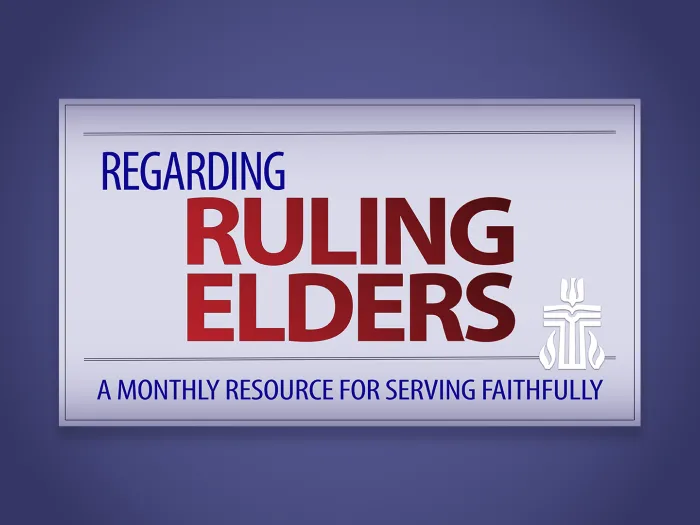Rooted: The Foundations of Presbyterian Polity — Mission of the Church: The Church and the Holy Spirit
Regarding Ruling Elders: A monthly series for serving faithfully

In the Presbyterian Church (U.S.A.), we affirm that the Church is the Body of Christ (F-1.0201) and Jesus Christ equips the Church to be an agent of Christ’s mission in the world (F-1.0202). But what does such a Church look like?
Part F-1.03 of the Foundations of Presbyterian Polity section in the Book of Order provides insights for answering this question. It offers us ways of naming what the Church is and is to be. It journeys through history to bring insights taken from across history and differing places.
The journey begins in the first century A.D., in the eastern Mediterranean region. F-1.0301 is built on 1 Corinthians 13:13, “And now faith, hope, and love remain, these three, and the greatest of these is love.” This part is carefully structured. Each of the three qualities gets its own brief paragraph, along with a fourth added in: witness. Each of the four paragraphs begins the same way: “The Church is to be a community of faith (hope/love/witness).” Faith is identified as trusting in God for what the Church needs to be healthy. Hope is rooted in the affirmation that the future is in God’s hands and that God is at work to bring Creation together in the new heaven and new Earth portrayed in the final chapters of the Book of Revelation. Love relies on God forgiving sin and bringing an end to hostility. The Church is a community of witness in that it points steadfastly to “the good news of God’s transforming grace in Christ Jesus as Lord.”
F-1.03 moves next to the fourth century, to the Nicene Creed. The Nicene Creed was formulated at two great councils of the church — first in the city of Nicaea, very near ancient Constantinople (present-day Istanbul), and the second in Constantinople itself. Historical note: the first of the councils met in the year 325, making this year its 1,700th anniversary. The Nicene Creed is recognized widely across denominations and churches as a primary statement of several core Christian beliefs and is included in our Book of Confessions. The Creed names four key marks of the identity of the Church: the Church is one, holy, catholic and apostolic.
Here again, F-1.03 is carefully constructed. Each of the Nicene marks is explored in a few paragraphs. The first paragraph for each Nicene mark starts the same way: “Unity (holiness/catholicity/apostolicity) is God’s gift to the Church in Jesus Christ.” Each first paragraph offers a definition of the mark. The second paragraph describes how the Church works to live out each mark. The first sentence of these second paragraphs is written the same way. Unity, for example: “Because in Christ the Church is one, it strives to be one.” At work here is the Christian affirmation that the Church and Christians are both already, in Christ, what they truly are, and at the same time are not yet what they truly are in all its fullness.
The next part of F-1.03 draws on a list of “Notes of the Reformed Church.” The list is found in Chapter XVIII of the Scots Confession, a document of the Protestant Reformation in the 16th century. The notes are true preaching of the Word of God, right administration of the sacraments, and church discipline and order. Each note of the church is framed for our time and place in a passage that is almost liturgical.
Then F-1.03 turns to the early 20th century, presenting a list of the “Great Ends of the Church,” articulated by the United Presbyterian Church of North America, one of the predecessor denominations to the PC(USA) (F-1.0304).
Completing the trinitarian pattern, F-1.04 focuses on the Holy Spirit. Repeatedly it identifies what happens “in the power of the Spirit.” The Spirit empowers continuity and change in our life together. The Spirit generates both unity and diversity. The Spirit draws us to be open.
Chapter 1 of the Foundations articulates what we are to be. Doing so highlights our failures to be that. We, with all Christians, are one, holy, catholic and apostolic. And we are not. We embody the notes of the Church. And we do not. We fulfill the Great Ends of the Church. And we do not. Living between what we are to be and what we are, we can draw strength from the Apostle Paul, who said, “Not that I have already obtained this or have already reached the goal, but I press on to lay hold of that for which Christ has laid hold of me.” (Philippians 3:12)
For Reflection:
- F-1.03 and F-1.04 offer us a variety of ways of understanding what the church really is. Which do you find most compelling? Why? How does that way of understanding the Church strengthen your ministry as a ruling elder?
- How does your congregation “witness through word and work to the good news of God’s transforming grace in Christ Jesus?” (F-1.0301)
Barry Ensign-George is a teaching elder in the Presbyterian Church (U.S.A.). He has served as a pastor in Iowa and at the denominational level in the Office of Theology & Worship.
Throughout 2025, monthly Regarding Ruling Elders articles will focus on the Foundations of Presbyterian Polity as included in our Book of Order. Ruling elders can benefit from these reflections as they consider their own ministries and call to serve as leaders in the Presbyterian Church (U.S.A.).
© 2025 Barry Ensign-George
Work licensed for publication in “Regarding Ruling Elders: A Monthly Series for Serving Faithfully.” Congregations and mid councils may print copies for educational use. Permission is needed for any other use, including copying and reprinting.
Subscribe to receive notifications of monthly Regarding Ruling Elders articles. Visit the PC(USA) Leader Formation website for more resources for ruling elders and deacons. For more information, email Martha Miller, editor of Regarding Ruling Elders.




